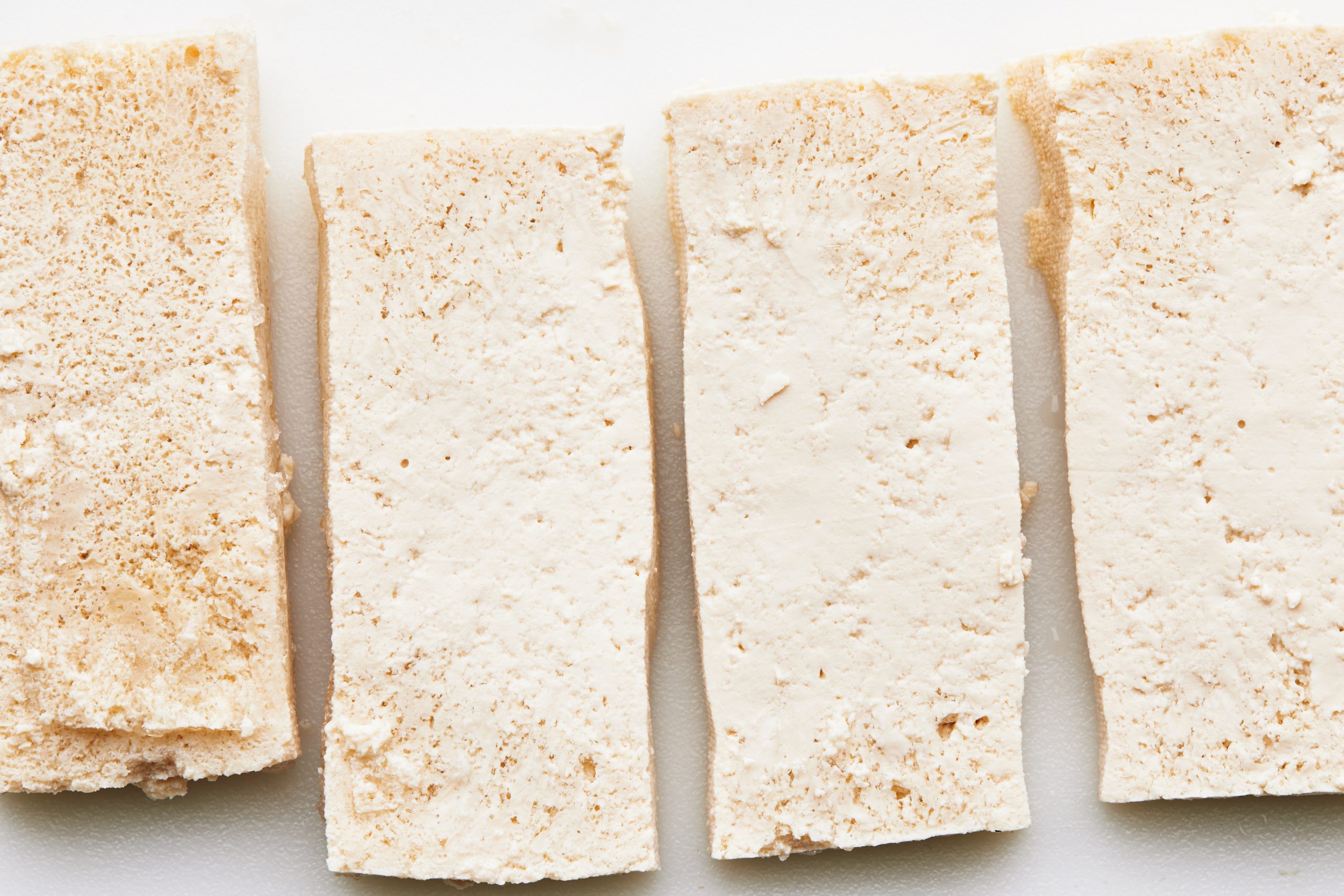Are you tired of the same old bland tofu?
Looking to elevate your stir-fries and deep-frying game?
Well, here’s a little secret ingredient that will transform your tofu experience: freezing!
Yes, freezing tofu not only gives it a unique spongy texture but also enhances its ability to soak up delicious flavors.
But that’s not all!
It can be conveniently stored for up to a month after a simple process of pressing out the water.
In this article, we’ll dive into the wonderful world of freezing tofu and discover its endless culinary possibilities.
freezing tofu
Freezing tofu produces a spongy texture.
This method, originally used in China and Japan to preserve tofu during winter, takes advantage of the fact that tofu is 86% water.
Freezing causes the water to expand and separate the protein network, resulting in a spongy and absorbent texture when thawed.
Frozen tofu absorbs sauce readily when stir-fried, has a resilient and slightly chewy texture, and forms a nice crust when deep-fried.
To freeze tofu, slice it into slabs and spread them in a single layer.
The frozen tofu can be stored for up to a month and should be thawed to room temperature before cooking.
It’s also important to press the frozen tofu to remove any remaining water before using it in recipes.
Key Points:
- Freezing tofu creates a spongy texture by expanding the water content and separating the protein network.
- Frozen tofu absorbs sauce easily when stir-fried and develops a chewy texture.
- It forms a nice crust when deep-fried.
- To freeze tofu, slice it into slabs and lay them in a single layer.
- The frozen tofu can be stored for up to a month and should be thawed to room temperature before use.
- Before cooking, it’s important to press the frozen tofu to remove any remaining water.
freezing tofu – Watch Video


Pro Tips:
1. Freezing tofu can change its texture and make it denser. By freezing tofu, you can achieve a chewier and meat-like consistency, ideal for dishes like stir-fries or grilling.
2. Freezing tofu can help it to absorb marinades better. The freezing process creates small ice crystals in the tofu, which creates pockets for flavor to seep into. This makes frozen tofu perfect for absorbing sauces and seasonings.
3. Freezing tofu can extend its shelf life. By freezing tofu, you can preserve it for up to several months. Be sure to drain and wrap the tofu properly to prevent freezer burn and maintain its quality.
4. Freezing tofu can alter its color. Frozen tofu often turns yellow when thawed due to its water content evaporating during the freezing process. However, this color change does not affect its taste or texture.
5. Freezing tofu can make it easier to crumble. If you freeze tofu and then thaw it completely, its texture becomes crumbly and resembles that of feta cheese. This crumbled tofu can be used as a vegan alternative in salads, tacos, or pasta dishes.
Introduction to Freezing Tofu
Tofu, a versatile and nutritious food made from soybeans, has gained widespread popularity in recent years. It has become a staple in vegetarian and vegan diets due to its high protein content and ability to absorb flavors. However, many people are unaware of the transformative power of freezing tofu.
By subjecting tofu to freezing temperatures, its texture changes dramatically, resulting in a spongy and absorbent consistency. In this article, we will explore the history of freezing tofu, its high water content, and how freezing alters its protein network. Additionally, we will delve into the various cooking methods that maximize the unique texture of frozen tofu and provide a step-by-step guide to freezing tofu at home.
Historical Use of Freezing Tofu in China and Japan
The technique of freezing tofu originated in China and Japan and has been employed for centuries to prolong the shelf life of tofu during the winter months. In these regions, tofu was traditionally made fresh on a daily basis. Freezing tofu became an important practice as it allowed people to have a convenient supply of this nutritious food even when soybean production was limited during colder seasons. Consequently, freezing tofu not only ensured a steady availability of this nutrient-rich food but also unintentionally resulted in the development of its distinctive spongy texture.
The High Water Content of Tofu
Tofu, a popular soy-based food, contains about 86% water. This high water content is essential for its ability to absorb flavors and achieve a soft and custard-like texture. Moreover, the water in tofu contributes to its delicate and fragile nature. However, when tofu is exposed to freezing temperatures, the water freezes and forms ice crystals. Consequently, these ice crystals expand and disrupt the protein network within the tofu, resulting in its separation.
How Freezing Causes the Protein Network to Separate
The process of freezing tofu causes a physical change in its structure. As the water freezes and expands, the ice crystals disrupt the protein network that holds the tofu together. The expansion of the ice crystals causes the network to break apart, resulting in a more porous and spongy texture.
This alteration in texture allows the tofu to absorb liquids more readily and enhances its capacity to hold onto flavors.
- Freezing tofu causes a physical change in structure
- Ice crystals disrupt the protein network, resulting in a porous texture
- Tofu absorbs liquids more readily and holds onto flavors better.
Resultant Spongy and Absorbent Texture After Thawing
Upon thawing, the frozen tofu undergoes a remarkable transformation. As the ice crystals melt, the water within the tofu drains away, leaving behind a spongy and absorbent texture. This texture is ideal for soaking up sauces and marinades, making it a delightful addition to stir-fries and other flavorful dishes. The spongy texture of frozen tofu acts as a sponge, soaking in the flavors and enhancing the overall taste of the dish.
Absorption of Sauce by Frozen Tofu when Stir-Fried
One of the remarkable qualities of frozen tofu is its ability to absorb sauce readily when stir-fried. Due to its spongy texture, frozen tofu acts like a flavor reservoir, soaking up the surrounding liquids and infusing the dish with a rich depth of taste. This absorption ability makes frozen tofu an excellent choice for stir-fries, where it can soak up the flavors of various sauces and spices, resulting in a delicious and satisfying dish.
- Frozen tofu has a spongy texture that allows it to absorb sauce easily.
- It acts like a flavor reservoir, enhancing the taste of the dish.
- Stir-frying frozen tofu allows it to soak up the flavors of sauces and spices.
- The result is a flavorful and satisfying dish.
“Frozen tofu acts like a flavor reservoir, soaking up the surrounding liquids and infusing the dish with a rich depth of taste.”
Resilient and Slightly Chewy Texture of Frozen Tofu
In addition to its spongy texture, frozen tofu also exhibits a resilient and slightly chewy consistency. This unique texture provides a pleasant mouthfeel and adds substance to dishes. When cooked, frozen tofu retains its shape and has a satisfying bite that complements other ingredients in a dish. Its resilience allows it to withstand the rigors of cooking methods such as grilling, stir-frying, and baking.
Formation of a Nice Crust when Deep-Frying Frozen Tofu
Frozen tofu is an incredibly versatile ingredient that not only absorbs flavors well, but also creates a crispy exterior when deep-fried. The spongy texture of frozen tofu allows it to develop a beautiful crust when exposed to high heat. This crispy outer layer perfectly contrasts with the soft and tender interior, resulting in a delightful textural sensation. Deep-fried frozen tofu is a great addition to any dish, providing a crunchy element that can be enjoyed as a standalone appetizer or as part of a more elaborate meal.
Step-By-Step Guide to Freezing Tofu
To freeze tofu at home and enjoy its unique texture, follow these simple steps:
- Begin by purchasing firm or extra-firm tofu.
- Drain the tofu from its packaging and gently press it with paper towels to remove excess moisture.
- Slice the tofu into slabs or cubes, depending on your preference.
- Arrange the tofu pieces in a single layer on a baking sheet or a plate lined with parchment paper.
- Place the baking sheet or plate in the freezer and allow the tofu to freeze for at least four hours or until solid.
- Once the tofu is frozen, transfer the tofu pieces to an airtight container or freezer bag. Label the container with the freezing date.
- Frozen tofu can be stored in the freezer for up to a month.
Tips for Storing and Preparing Frozen Tofu
When cooking with frozen tofu, follow these tips for the best results:
- Thaw the frozen tofu by transferring it from the freezer to the refrigerator. Allow it to thaw overnight or for at least six to eight hours.
- Once thawed, gently press the tofu to remove any remaining water. This step improves its texture and absorbency.
- Cut the tofu into desired shapes or sizes for your recipe.
- Marinate the thawed tofu to infuse it with delicious flavors.
- Use frozen tofu in stir-fries, soups, curries, and any other recipe where you want it to absorb abundant flavors.
Freezing tofu is a simple yet effective way to alter its texture and unlock new culinary possibilities. By understanding the history, science, and techniques behind freezing tofu, you can maximize its spongy and absorbent qualities in various cooking methods. Whether you choose to stir-fry, deep-fry, or incorporate frozen tofu into other dishes, its resilient and slightly chewy texture will provide a delightful and flavorful experience.
- Thaw tofu in the refrigerator for best results
- Gently press tofu to remove water
- Cut tofu into desired shapes
- Marinate to add flavor
- Use in stir-fries, soups, curries, and more

You may need to know these questions about freezing tofu
Does tofu freeze well?
Yes, tofu freezes very well and it’s a popular method to extend its shelf life and enhance its texture. Unlike silken tofu, all other types of tofu are suitable for freezing. By draining, drying, slicing, and freezing the tofu, its structure is altered, resulting in a meatier texture. When you’re ready to use it, simply thaw it out, and enjoy the transformed tofu in your favorite dishes.
What is the best way to freeze tofu?
To freeze tofu, it is important to follow a few simple steps. Begin by placing whole blocks of tofu in a single layer on a baking sheet or plate, ensuring they are not touching each other. Freeze them overnight, allowing the tofu to retain its moisture. Once frozen, transfer the tofu to an airtight container to prevent freezer burn and maintain its quality. By freezing the tofu in this manner, it will be preserved and ready to use for future dishes, maintaining its texture and flavor.
Can you freeze tofu in the package it comes in?
Yes, freezing tofu in its original packaging is completely safe and convenient. As long as the package is intact and properly sealed, there is no need to transfer the tofu to another container before freezing. Whether it is vacuum-sealed or in water-filled containers, freezing tofu in its original packaging maintains its freshness and texture. Just ensure that any excess water is drained off before freezing if the tofu is packaged with water. Freezing tofu in its original packaging allows for easy storage and preserves the tofu’s quality when thawed.
Does freezing tofu make it crispy?
Yes, freezing tofu transforms its texture and is key to achieving a crispy result. When tofu is frozen and then thawed, it undergoes a change in texture, becoming denser and more porous. This change allows it to absorb marinades more effectively, resulting in enhanced flavor. Furthermore, when frozen tofu is fried, the water content within the tofu turns to ice crystals, creating small pockets and air gaps. As a result, the tofu becomes incredibly crispy on the outside while maintaining a soft and tender interior. So, freezing tofu not only makes it better for marinating but also ensures a delightful crispy texture when cooked.
Reference source
https://www.americastestkitchen.com/cooksillustrated/how_tos/6637-freeze-tofu-first-for-texture-that-soaks-up-more-sauce
https://www.eatingwell.com/article/8053919/freezing-tofu/
https://www.foodnetwork.com/how-to/packages/food-network-essentials/can-you-freeze-tofu
https://soyaeats.com/can-you-freeze-tofu/



